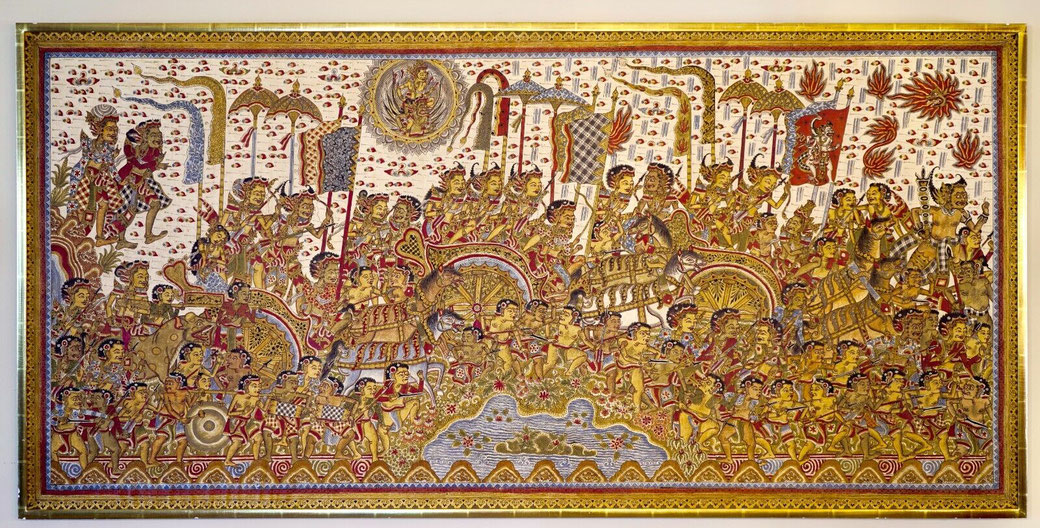klungkung
Klungkung is the smallest regency on the island in terms of both land area and population.
Location: Klungkung Regency is situated on the eastern coast of Bali. It is bordered by the Badung Regency to the northwest, Bangli Regency to the north, and Karangasem Regency to the east. To the south lies the Indian Ocean.
Administrative Division: Klungkung Regency is further divided into several districts, including Klungkung, Dawan, Banjarangkan, and others.
Culture and History: The regency holds historical significance as it was once the seat of the powerful Klungkung Kingdom, which played a crucial role in Bali's history. The regency is home to some ancient and culturally important landmarks and temples, which attract tourists interested in Balinese heritage and architecture.
Attractions: One of the main attractions in Klungkung Regency is the Kertha Gosa, a historical court of justice known for its intricate ceiling paintings depicting various Balinese mythological stories. The nearby floating pavilion, called Bale Kambang, is another popular site. Other points of interest include Goa Lawah Temple (Bat Cave Temple) and traditional villages like Tenganan, known for preserving ancient Balinese traditions.
Agriculture and Economy: The economy of Klungkung is primarily based on agriculture, with rice, coconut, and fruit being some of the main crops grown in the region. Additionally, tourism also plays a role in the local economy, as visitors come to explore its cultural heritage and natural beauty.
History of the Klungkung Kingdom
The history of Klungkung and its kingdom is rich and deeply intertwined with the broader history of Bali, Indonesia. Here is an overview of the key historical aspects of Klungkung and its kingdom:
The Klungkung Kingdom's Founding: The Klungkung Kingdom, also known as the Gelgel Kingdom, was established in the 17th century by Dewa Agung Jambe. He was a descendant of the Majapahit Kingdom, which was a powerful empire in Java before it fell to the spread of Islam and the rise of Muslim Sultanates.
Rise to Power: Under the rule of Dewa Agung Jambe, the Klungkung Kingdom flourished and expanded its influence over other regions of Bali. The kingdom's golden era was during the reign of Dewa Agung Made Karna, also known as the "Dalem Waturenggong," who ruled from 1710 to 1736.
Gelgel Dynasty: The Gelgel dynasty was the ruling dynasty of the Klungkung Kingdom. It played a crucial role in shaping the kingdom's culture, arts, and governance during its existence.
Development of Klungkung as the Cultural Center: Klungkung emerged as the cultural and artistic center of Bali during the Gelgel dynasty's rule. The kingdom supported the development of traditional Balinese arts, literature, and religious practices.
Klungkung's Influence: The Klungkung Kingdom was not only influential on Bali but also had significant sway over neighboring islands. It maintained diplomatic relations with other kingdoms in Indonesia and traded with foreign merchants.

Dutch Colonization: In the late 19th century, the Dutch colonial forces began their expansion into Bali. They gradually took control of various Balinese regions, including Klungkung. The kingdom fiercely resisted Dutch rule, resulting in a series of battles known as the "Puputan Klungkung" in 1908.
The Puputan Klungkung: On September 28, 1908, the Dutch attacked the royal palace of Klungkung, leading to a last stand by the royal family and its followers. The ruler at the time was Dewa Agung Gusti Agung Nengah, along with his entire court and many loyal subjects. They chose ritual suicide (puputan) rather than surrendering to the Dutch. This tragic event became a symbol of Balinese resistance against colonial rule.
The End of the Kingdom: With the fall of Klungkung, the independent Klungkung Kingdom effectively came to an end. Bali eventually became a part of the Dutch East Indies, which later became Indonesia after gaining independence in the mid-20th century.
Today, Klungkung remains an important cultural and historical center in Bali, with various landmarks and monuments dedicated to preserving the memory of its kingdom's past. The legacy of the Klungkung Kingdom continues to be a source of pride and inspiration for the people of Bali.
Klungkung city or semarapura
Klungkung, also known as Semarapura, is a town and the capital of Klungkung Regency. It is located in the eastern part of the island and holds historical and cultural significance.
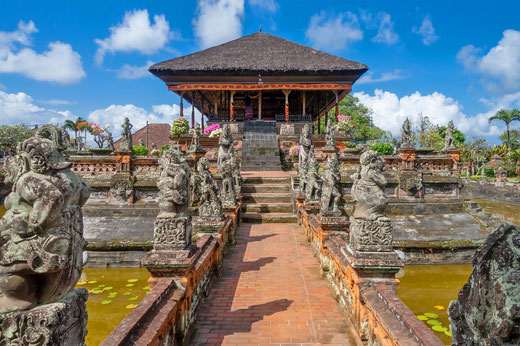
History:
Klungkung has a rich history and was once the center of the Klungkung Kingdom, also known as the Gelgel Kingdom, which ruled over Bali in the late 17th and early 18th centuries. The town's historical prominence is evident through its notable landmarks, palaces, and temples.
Kerta Gosa:
One of the most famous attractions in Klungkung is the Kerta Gosa, also known as the Hall of Justice. It is a historical landmark that served as the court of justice during the Klungkung Kingdom's reign. The main pavilion, adorned with intricate paintings on its ceilings, depicts scenes from ancient Hindu epics like the Mahabharata and Ramayana. These paintings were not only used for their aesthetic value but also to teach moral and ethical lessons to those brought before the court.
Puri Semarapura:
Puri Semarapura is the royal palace complex in Klungkung, which once served as the residence of the Klungkung kings. Although much of the original palace was destroyed during a Dutch colonial attack in 1908, some parts of it have been reconstructed and preserved. The palace complex offers insights into the architectural and cultural heritage of the Klungkung Kingdom.
This busy market town on the main road to Besakih and Amlapura is steeped in history and has some noteworthy sites, the Semara Pura Palace complex which houses the Hall of Justice and Kambang Pavillion. The market here sells interesting textiles woven in the Eastern part of Bali. Another thing to buy here is sea salt panned from the nearby beaches.
Kerta gosa or taman gili palace
Kerta Gosa, also known as the Hall of Justice, is a historical landmark located in Klungkung.. It is one of the most significant cultural and architectural sites on the island and holds great historical and artistic value.
History:
Kerta Gosa was once part of the royal palace complex of the Klungkung Kingdom, which ruled over Bali in the 17th and 18th centuries. It served as the court of justice and was used to administer the kingdom's legal matters, including disputes and criminal cases. The pavilion was also a place for royal ceremonies and important religious gatherings.
Architectural Features:
The main attraction of Kerta Gosa is the floating pavilion, known as Bale Kerta Gosa, which is characterized by its intricate and beautifully painted ceilings. The pavilion is designed in a traditional Balinese architectural style, featuring intricately carved wooden beams and a thatched roof.
Ceiling Paintings:
The most striking feature of Kerta Gosa is the elaborate paintings on the ceilings of the pavilion. The paintings are depicted in the traditional Kamasan style, a Balinese form of art influenced by the Wayang-style puppetry and Hindu-Balinese mythology. These paintings depict scenes from ancient Hindu epics such as the Mahabharata and Ramayana.
The artists used the paintings as a visual representation of the
kingdom's laws and justice system.
They were intended to serve not only as an ornamental display but also as a means of imparting moral and ethical lessons to the people. The paintings aimed to emphasize the consequences of committing crimes and the importance of upholding justice and righteousness in society.
Tourist Attraction:
Today, Kerta Gosa is a popular tourist attraction in Bali, drawing visitors who are interested in the island's cultural and historical heritage. The stunning paintings and the historical significance of the place make it a must-visit spot for those exploring the island.
Surroundings:
Kerta Gosa is located in the heart of Klungkung town, making it easily accessible to tourists. The site is surrounded by beautiful gardens and traditional Balinese architecture, adding to the overall ambiance of the place.
Cultural Significance:
Kerta Gosa serves as a reminder of Bali's rich cultural and historical heritage. It reflects the importance of justice and the rule of law in the traditional Balinese society and showcases the artistic talents of Balinese painters and craftsmen.
Visiting Kerta Gosa provides an opportunity to immerse oneself in the cultural and historical essence of Bali, making it a rewarding experience for travelers interested in exploring the island's heritage beyond its stunning landscapes and beaches.
Bale Kambang
Bale Kambang, also known as the Floating Pavilion, is a prominent feature of the Taman Gili Palace (Taman Gili Kertha Gosa) in Klungkung regency. It is one of the two main structures within the palace complex, the other being the Kertha Gosa pavilion.
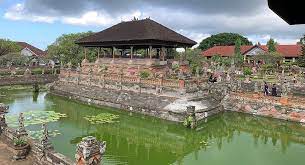
Bale Kambang is a unique and picturesque pavilion situated in the middle of a large rectangular pond filled with lotus flowers. The name "Bale Kambang" translates to "Floating Pavilion" in the Indonesian language, which aptly describes its appearance as if it is floating on the water. The pavilion is supported by several pillars, and it has a spacious open design with a roof to provide shade.
This striking architectural feature adds to the overall charm of the Taman Gili Palace and is a popular spot for tourists to visit and take photographs. The serene and tranquil setting of the pavilion surrounded by water and lotus flowers creates a calming atmosphere, making it an enjoyable place to spend some time.
Bale Kambang is often used for cultural events, ceremonies, and traditional performances, reflecting its significance as a venue for preserving and showcasing Bali's rich cultural heritage. It serves as a reminder of the island's royal history and traditional architectural styles, attracting both local and international visitors interested in exploring Bali's cultural identity.
Goa Lawah, Bat Cave
Goa Lawah, also known as the Bat Cave Temple, is a significant Hindu temple located in the Klungkung regency of Bali. The temple is one of the nine directional temples that are meant to protect the island from evil spirits. It is situated approximately nine kilometers southeast of Klungkung town, close to the coastal village of Pesinggahan.
The name "Goa Lawah" translates to "Bat Cave" in Indonesian, and it is precisely named due to the large number of bats that inhabit the cave within the temple complex. The cave is considered sacred and is an integral part of the temple's spiritual significance.

Architecture: The temple itself is built in a Balinese architectural style, featuring black stone structures adorned with intricate carvings. As with many Balinese temples, it reflects a harmonious blend of Hindu and indigenous Balinese design elements.
Spiritual Significance: Goa Lawah holds a special place in Balinese Hinduism. It is believed to be a spiritual gateway, and the cave is associated with Mount Agung, the highest and most sacred mountain in Bali. The temple is dedicated to the god Maheswara, representing one of the aspects of the Hindu Trimurti, which comprises Brahma (the creator), Vishnu (the preserver), and Shiva (the destroyer).
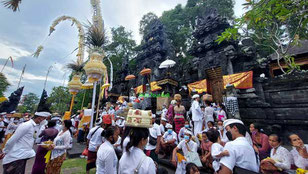
Ceremonies and Rituals: Regular ceremonies and rituals are held at Goa Lawah Temple to honor the deities and seek protection and blessings. Balinese Hindus often come here to offer prayers and make offerings to the gods and ancestors.
Goa Lawah Temple and the Sea: The temple's location near the coast contributes to its significance. Balinese Hinduism often emphasizes the relationship between the sea and spirituality, and Goa Lawah exemplifies this connection.
Visitors to the temple should dress modestly and respectfully, as is customary when visiting any Balinese Hindu temple. Goa Lawah is a popular tourist attraction due to its unique setting, cultural significance, and the opportunity to witness the mesmerizing spectacle of bats streaming out of the cave during sunset.
Gelgel
The royal household was based in the village Gelgel in the 15th century. Both the Jero Agung and Dasar temples are worth visiting, the latter being reserved for ceremonies of higher caste or aristocracy of Bali.
Kamasan
Kamasan is renowned for its historical significance and traditional art form known as "Kamasan painting" or "Kamasan-style painting."
Kamasan painting is a unique and intricate form of Balinese art that dates back several centuries. It originated in the village of Kamasan during the time of the Klungkung Kingdom and has been passed down through generations of artists. The paintings typically depict scenes from Hindu epics like the Ramayana and Mahabharata, as well as other religious and mythological narratives. The style is characterized by fine lines, elaborate detailing, and the use of gold leaf for highlights.
The Kamasan-style paintings were historically used to decorate the walls of temples and palaces in Bali, playing a significant role in Balinese religious and cultural life. Today, while some of the traditional roles of these paintings have evolved, Kamasan artists continue to create exquisite works of art that are highly sought after by collectors and art enthusiasts.
Visiting Kamasan village provides an opportunity to witness the artistic heritage of Bali and engage with local artists who are still practicing this ancient craft. Some artists may welcome visitors to their studios, allowing them to observe the painting process and learn about the techniques and symbolism behind the artworks.
In addition to its artistic importance, Kamasan village offers a glimpse into traditional Balinese village life, with its distinctive architecture, religious ceremonies, and cultural practices. Exploring the village and its surroundings can provide a deeper understanding of Balinese culture and the artistic legacy that continues to thrive in the region.
Kusamba

Kusamba is a coastal village located in the Klungkung Regency. It is situated on the eastern coast of the island, along the Indian Ocean. The village is known for its traditional salt farming practices and its black sand beaches.
Salt farming has been a significant economic activity in Kusamba for centuries. The villagers use a traditional method to produce salt, which involves evaporating seawater in shallow pools or pans. As the water evaporates, it leaves behind salt crystals that are then collected and processed. The salt is used for various purposes, including culinary and ceremonial uses.
Visiting Kusamba allows tourists and visitors to witness the salt farming process and gain insights into the traditional way of life of the local community. It's an opportunity to learn about the importance of salt in Balinese culture and cuisine.
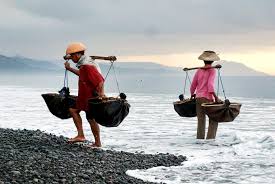
Besides salt farming, Kusamba is also known for its fishing activities. Local fishermen use traditional techniques to catch fish and other seafood from the ocean, contributing to the village's economy and sustenance.
As Kusamba is located on the coast, it offers beautiful views of the Indian Ocean and unique black sand beaches. The black sand is a result of volcanic activity in the region. While the beaches in Kusamba might not be as popular for swimming or recreational activities as other beaches in Bali, they still offer a tranquil and less crowded setting for those seeking a more peaceful coastal experience.
Paksa
Paksa is a village famous for re-enactments of ancestral battles. The participants re-enact these battles while they are in a trance.
tukad unda
Tukad Unda is known for its beautiful and serene natural surroundings, particularly the Tukad Unda Dam and the river that flows through the area.
The Tukad Unda Dam, also known as the Tukad Bangkung Dam, is a significant water reservoir and irrigation system built on the Tukad Unda River.
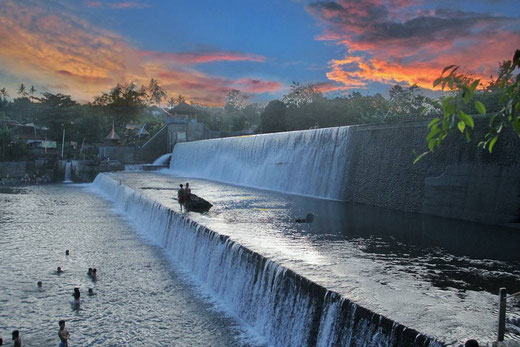
The dam was constructed to help manage water resources and provide irrigation for the surrounding agricultural lands. It also serves as a flood control measure during the rainy season.
The scenic beauty of Tukad Unda, with its lush greenery and tranquil river, has attracted both locals and tourists alike. The area is a popular spot for picnics, photography, and relaxation, as visitors can enjoy the picturesque views and the soothing sound of the flowing river.
Many people visit Tukad Unda for recreational activities such as swimming and rafting in the river. The length of the rafting is about 9 kilometers and at this rafting band you will meet about 22 barricades. The river's calm and clear waters make it suitable for leisurely swims and family outings. Additionally, some local operators offer rafting experiences on the Tukad Unda River, allowing visitors to enjoy a gentle rafting adventure amidst the natural beauty of the region.
Nusa Penida

Nusa Penida is a beautiful and relatively untouched island located off the southeastern coast of Bali, Indonesia. It is part of the Nusa Islands, which also include Nusa Lembongan and Nusa Ceningan. Nusa Penida has gained popularity as a tourist destination due to its stunning landscapes, pristine beaches, and diverse marine life.
History:
The history of Nusa Penida is intertwined with the history of Bali, as it was once part of the ancient Balinese kingdom. In the past, the island served as a place of exile for the kingdom's wrongdoers. However, the island remained relatively isolated and underdeveloped until recent years when tourism began to flourish in the region.
Touristic Highlights:
Kelingking Beach: One of the most iconic and Instagram-worthy spots on Nusa Penida is Kelingking Beach. It is famous for its stunning viewpoint, resembling the shape of a T-Rex. The hike down to the beach can be challenging but rewarding, offering breathtaking views.

Angel's Billabong and Broken Beach: These two natural wonders are located close to each other. Angel's Billabong is a natural infinity pool formed by the tide, and Broken Beach is a picturesque circular cove with a natural arch.
Crystal Bay: This is one of the best spots for swimming and snorkeling on the island. The water here is crystal clear, and you can often spot manta rays and other marine life.
Atuh Beach: Another beautiful beach on Nusa Penida known for its stunning rock formations and clear blue waters. It's a great spot for relaxation and enjoying the natural beauty of the island.
Tembeling Forest and Beach: A more secluded and peaceful area, Tembeling is known for its lush forest and two natural pools. The trek to get here is a bit more challenging, but it's well worth the effort.
Pura Goa Giri Putri: This unique Hindu temple is located inside a cave and is an essential cultural and religious site on the island.
Snorkeling and Diving: Nusa Penida offers fantastic opportunities for snorkeling and diving. Manta Point is one of the most famous dive sites, where you can swim with graceful manta rays.
Sebela Village: For a taste of the local life and culture, consider visiting Sebela Village. Here, you can witness traditional ceremonies and experience the island's authentic charm.
Nusa Lembongan
Nusa Lembongan is part of a group of three islands, including Nusa Penida and Nusa Ceningan, collectively known as the Nusa Islands. Let me provide you with some information about its history and tourism:
History:
Nusa Lembongan, like many Indonesian islands, has a rich cultural and historical background. The island was initially settled by people from the neighboring island of Bali. Over the years, fishing and seaweed farming have been essential economic activities for the local population. The island's unique charm, natural beauty, and proximity to Bali have attracted visitors seeking a more serene and less crowded environment than the main island.
Tourism:
Tourism on Nusa Lembongan has been steadily growing, and the island is now a popular destination for both international and domestic travelers. The island's appeal lies in its stunning beaches, crystal-clear waters, vibrant coral reefs, and laid-back atmosphere. Some of the popular attractions and activities on Nusa Lembongan include:
Beaches: Dream Beach, Mushroom Bay, and Sandy Bay are among the picturesque beaches where visitors can relax, swim, and enjoy the views.
Snorkeling and Diving: The surrounding waters are rich in marine life, making snorkeling and diving popular activities. There are several dive centers that offer trips to nearby dive sites.
Devil's Tear: A scenic spot where waves crash against the rocks, creating an impressive spectacle.
Seaweed Farms: Visitors can learn about the traditional seaweed farming methods, which are an essential part of the local economy.
Mangrove Forest: Take a boat tour through the island's mangrove forest and witness the unique ecosystem.
Surfing: Nusa Lembongan offers surf breaks suitable for beginners and experienced surfers alike.
Island Hopping: Explore the neighboring islands of Nusa Penida and Nusa Ceningan, which are connected by a yellow bridge.
Sunset Views: Witness breathtaking sunsets from various viewpoints around the island.
Tourism infrastructure on Nusa Lembongan has developed significantly in recent years, with various accommodations ranging from budget guesthouses to luxury resorts. There are also numerous restaurants, cafes, and beach clubs that cater to the needs of travelers.
Nusa Ceningan
Nusa Ceningan, like its neighboring islands, has a rich history deeply rooted in Balinese culture. The island was likely inhabited by the Balinese people for centuries, and it has been influenced by Hinduism, which is the predominant religion in Bali and surrounding areas. However, historical records specific to Nusa Ceningan's history might be limited compared to the more prominent islands like Bali.

Nusa Ceningan is known for its breathtaking landscapes, crystal-clear waters, and relaxed atmosphere. While it's the smallest among the three Nusa Islands, it has become increasingly popular with tourists seeking a quieter and more laid-back experience compared to the bustling areas of mainland Bali.
Scenic Beauty: The island is known for its scenic coastal cliffs, picturesque beaches, and stunning blue lagoon, offering visitors plenty of opportunities for relaxation and exploration.
Activities: Nusa Ceningan offers various water-based activities, such as snorkeling, diving, and surfing. The waters surrounding the island are home to vibrant marine life, including manta rays, colorful fish, and coral reefs.
Suspension Bridge: One of the notable attractions on the island is the Yellow Bridge, which connects Nusa Ceningan to Nusa Lembongan. The bridge is a popular spot for tourists, providing a scenic walk and excellent photo opportunities.
Cultural Experiences: While Nusa Ceningan is not as densely populated as Bali, you can still experience Balinese culture through interactions with the local community, visiting temples, and witnessing traditional ceremonies if you are lucky to be there during such events.
Tranquility: Nusa Ceningan is a great destination for travelers looking to escape the crowds and experience a quieter, more secluded atmosphere compared to Bali's main tourist areas.
comments
This list is for sure not complete. We welcome your comments and encourage you to share additional touristic, cultural, or historical facts about this regency. Your insights will benefit other readers visiting this page.





